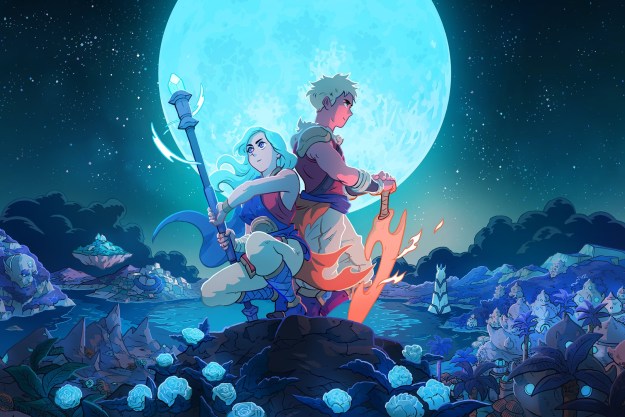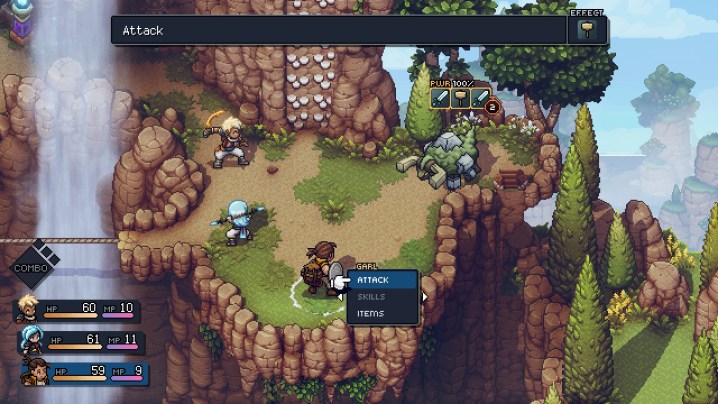
“Sea of Stars goes beyond retro homage to deliver a moving indie RPG with a strong combat system at its heart.”
- Funny, but meaty story
- Engaging combat
- Diverse settings
- Moving soundtrack
- Limited fast travel
- Easy to get stuck
I didn’t expect Sea of Stars to exceed any expectations. It starts with two heroes and their comic relief friend on a quest to fulfill their prophecies … or whatever. Its initial fourth-wall-breaking humor had me prepared for a light meta RPG. Then, after a hell of a mood shift at the halfway point, I realized that the stellar combat and map design was actually attached to an emotionally evocative and competently crafted story.
Zale and Valere are Solstice Warriors, those born on a solstice and trained in the art of Eclipse Magic. They live in a world tormented by the sorcerer Fleshmancer’s creations, especially Dwellers, the most powerful of them all. After years of training, Zale and Valere set out on a mission to quell what’s supposedly the last Dweller. However, their story ends up being much more than that as they explore new territories, foes, and a prophecy that they didn’t know extended beyond stars. It’s a gripping interstellar journey that I’m glad I stuck with.
Sabotage Studios blends aspects from Super Mario RPG, Illusion of Gaia, and Chrono Trigger to create Sea of Stars, its largest RPG yet. It incorporates combat quirks like timed hits and dual attacks that force you to pay attention way after you’ve selected a move, and keeps encounters exciting with the diverse enemies throughout the colorful, pixelated landscapes. All that, plus respectable storytelling, make it the best indie RPG that I’ve played this year.
Surprisingly thought-provoking story
On the surface, Sea of Stars’ story is like every other fantasy RPG starring superpowered teenagers on a quest to save the world. However, it subverts the trope with a change in tone toward the middle of the adventure, even though it keeps the amusing dialogue throughout.

Its story leans into humor as hard as it does into heavier topics like grief and obligation. I expected it to keep the lighthearted tone it had at the start without delving into characters’ emotions as much as it did. In the end, it impressed me with how it had me at the edge of my seat with the expressive portraits, climatic music, and dramatic animations at the tensest moments of the game.
However, you will probably enjoy Sea of Stars a lot more if you suspend disbelief. It still suffers from the goofy or otherwise convenient happenstances found in anime fantasy games. Sea of Stars isn’t a game I’d play solely for the story. After all, there are many games with good stories. But I’d recommend it based on how the story blends with the rest of the package.
Turn-based combat with a twist
Sea of Stars‘ crown jewel is its combat, from its lively, animated sprites to its “lock” system that encourages players to hit enemies with the right type of weaknesses before they unleash their next move. It features a turn-based combat system where players control up to three party members and freely choose which one acts first in a given turn. Characters can be swapped for a number reasons, including to survive an enemy attack or to counter a type weakness. These rules encouraged me to use all my party members because each one felt like they had a purpose, something that sometimes gets lost in translation when RPGs have too many characters.

Timed hits especially stand out. Sea of Stars rewards you for pressing buttons at just the right time, allowing you to break two weaknesses at once or deal more damage than you typically would. If I timed my presses just right, I could weaken an enemy twice as much with the right character. Characters can perform combos or “ultimates” after they build up enough energy from landing hits on enemies, so managing those meters added to the challenge. Players can also use a “live mana” ability to infuse characters with magic for breaking weaknesses, even if they’re out of mana.
All this to say that Sea of Stars’ combat offers a refreshing change of pace. The timed hits make me feel like I’m an active participant in all the battles. If you don’t like something about the combat, you can also adjust it to some extent with a Relic, an item that can increase or lessen the difficulty of your playthrough. I didn’t use many because I wanted to keep the experience as pure as possible, but I did use one that implemented a “signal flare” to more clearly indicate whether or not I timed a hit properly.
What a wonderful, confusing world
Sea of Stars is almost as much of a puzzle game as it is an RPG. Each of its map challenges players to utilize environmental tools and powers they’ve collected throughout their playthrough. For example, there’s a wind ability that can move platforms along a set path. It can be used to solve puzzles like powering a raft or pushing platforms into open slots in a wall like a key. Some parts also include minigames like matching tiles based on memory to unlock the next section of a map.
Sabotage keeps the grindiest parts about RPGs out of Sea of Stars.
It feels satisfying to finally finish puzzles after racking my brain over certain solutions for several minutes. However, Sea of Stars could benefit from an objective marker or other way of hinting at what to do next, so that it isn’t as easy to get “stuck.” Those moments where I stalled for an answer were long enough that I dreaded not being able to find my way through a course. It might not be enough to turn me away, but it could easily persuade a less patient player to put down the controller.
For the most part, Sabotage keeps the grindiest parts about RPGs out of Sea of Stars. You won’t be forced to engage in combat in random encounters, though monsters will chase after you if they see you in their line of sight. You also jump straight into battle without a transition, so fights feel breezy without loading screens breaking them up. Grinding is obsolete, so I can battle a handful of enemies here and there without running through the map over and over, just to level up for a boss fight.

Sea of Stars also does an impressive job of removing backtracking, which is crucial for a game with limited fast travel. Players might come across a hidden shortcut after completing a stage, like a river that carries them back to the entrance, or find that a closed-off part of the map is suddenly accessible because of a new tool or power they’ve earned. These little additions remove as many inconveniences as possible without copying the formula from modern RPGs.
However, better fast travel would have been welcome due to how vast the world is. There are a few options, like living statues that throw (and spit) you between select islands, but revisiting most of the towns becomes a chore. Steering a haunted pirate ship between the locales might be cool, but it’s not exactly convenient.
If you can live with some of its missing pieces, Sea of Stars is an impressive homage to classic RPGs. It does that without simply leaning on retro nostalgia. Instead, it delivers a unique adventure all its own filled with humor, dramatic weight, and a creative battle system that’s entirely its own. It’s both a respectful look back at the past and a bold step forward for indie RPGs.
Sea of Stars was reviewed on a PlayStation 4.




